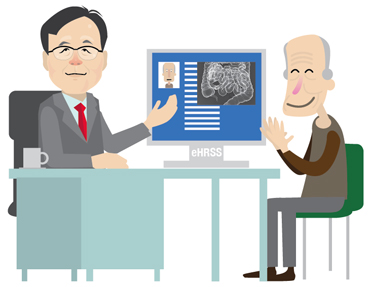 |
|
Public-Private Partnership (PPP) programmes can benefit patients and private doctors are positive about
them. These programmes could hardly be carried out without the Electronic Health Record Sharing System
(eHRSS). Two participating private doctors shared their experiences. |
|
|
| |
| The CRC Experience |
| |
Dr Chan Pui Kwong, a specialist in community medicine, has enrolled in the Colorectal Cancer Screening Pilot Programme (CRC), a PPP programme launched by the Department of Health to help prevent colorectal cancer.
|
|
 |
|
| |
| eHR Sharing in CRC |
| |
| Under CRC, both participating doctors and patients have to register with eHRSS. Riding on the electronic
health record (eHR) sharing platform, the CRC information technology system allows case tracking,
keeping of test results and outcome screening that follows the screening pathway, and eHRSS has
facilitated CRC patients to be served by a team of multi-disciplinary healthcare providers (HCPs) based on
the shared data. |
| |
| “Once results of the screening have been uploaded by laboratories to the system, we will immediately
know whether a patient needs further referral or not,” said Dr Chan. |
| |
| So far, four of Dr Chan’s patients have been confirmed with colorectal cancer through the programme.
“CRC has benefited many patients and eHRSS has played a part. Without the system, time will be wasted
and extra cost incurred in transmitting the information. Collaboration between doctors and timely treatment
to patients cannot be realised.” |
| |
| Benefits of eHRSS |
| |
|
The benefits of eHRSS are not only manifested in PPP programmes, as illustrated in a case shared by Dr
Chan.
|
| |
A patient with severe chronic hepatitis came to Dr Chan for consultation after undergoing hernia surgery. He has lost half of his body weight after the surgery, and his liver cirrhosis has also worsened.
The patient’s family was deeply worried whether something has gone wrong with the surgery or the patient has developed cancer. As it would be some time before the patient’s next visit to the public hospital, they sought help from Dr Chan.
With eHRSS, Dr Chan was able to check the patient’s discharge summary for reference and assessed that the patient did not have cancer and there was not any complication with the surgery. “The records in eHRSS have assisted me in making the assessment and timely relaying the findings to the patient’s family, which I believe has given them great relief.” said Dr Chan. |
| |
 |
| |
| The GOPC PPP Experience |
| |
Dr Douglas Chan, Council Member of the Hong Kong Medical Association, has
joined for years as a participating doctor in several PPP programmes launched by
the Hospital Authority (HA), including the General Outpatient Clinic Public-Private
Partnership Programme (GOPC PPP). |
|
 |
|
| |
| eHR Sharing in GOPC PPP |
| |
| The GOPC PPP provides a choice to selected HA patients to receive primary care services from the
private sector. Like other PPP programmes, both participating patients and doctors are required to register
with eHRSS so that patient-based information can be shared among private clinics and public hospitals. |
| |
| Holding positions as the co-chairman of the Task Force on PPP and the Focus Group on GOPC PPP of the Hong Kong Medical Association, Dr Chan said GOPC PPP not only helps ease the pressure on primary care service in the public healthcare sector, it also benefits patients in many ways. |
| |
| “It provides patients with more choice for receiving primary healthcare, greater convenience and flexibility. It also means more timely treatment as well as quality healthcare services to patients,” he commented. |
| |
| Dr Chan said the more precise records shared through eHRSS, such as medication and drug allergy histories of patients, are particularly useful to doctors. To further improve the workflow of prescription record entry in GOPC PPP, Dr Chan suggested that templates of commonly used medication could be built in the GOPC module for doctors’ selection. |
| |
| “Furthermore, adding a shortcut at the PPP prescription interface in the GOPC module will help doctors know at a glance if the patient has drug allergy or adverse reactions,” he added. |
| |
| Benefits of eHRSS |
| |
Describing eHR sharing as a global trend, Dr Chan said the
exchange of health information can help achieve seamless
healthcare services for patients and better collaboration
between the public and private healthcare sectors, benefiting
both patients and HCPs. Dr Chan shared the following real
case.
A patient was suffering from hoarseness which might be the
symptom of nasopharyngeal cancer. While anxiously waiting for
the next appointment at public hospital for medical test results,
the patient consulted Dr Chan. Having joined eHRSS, Dr Chan
was able to access the patient’s test reports at the system and
give his advice.
“With eHRSS, laboratory or investigation results at public
hospitals are accessible by private doctors, and at the patients’
choice, private doctors can diagnose and prepare treatment
plans for them more efficiently. It can also help reduce the
unnecessary anxiety of patients who otherwise would have to
wait for a longer time to get the results,” said Dr Chan.
|
|
|
|
| |
|
|
| |
|

